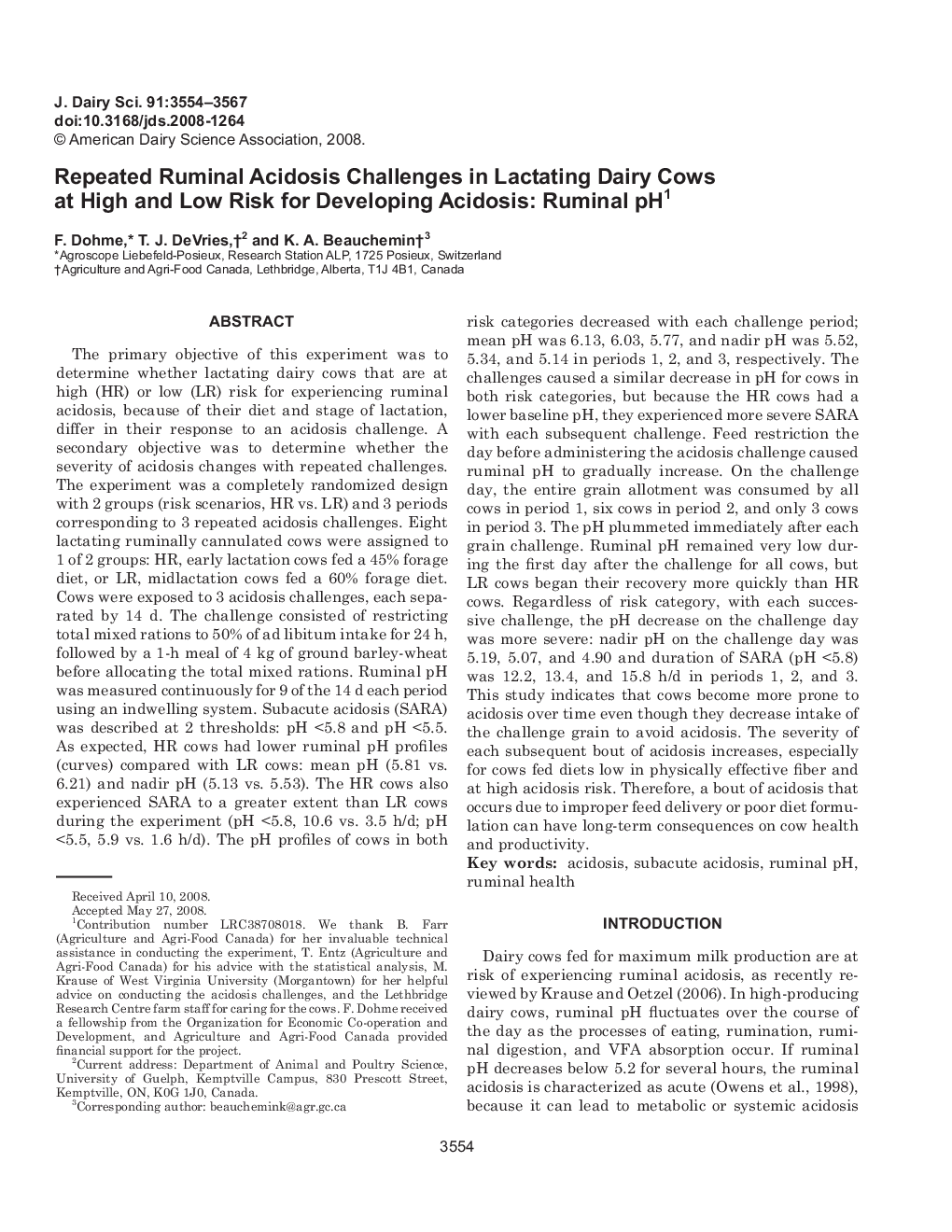| Article ID | Journal | Published Year | Pages | File Type |
|---|---|---|---|---|
| 2439531 | Journal of Dairy Science | 2008 | 14 Pages |
Abstract
The primary objective of this experiment was to determine whether lactating dairy cows that are at high (HR) or low (LR) risk for experiencing ruminal acidosis, because of their diet and stage of lactation, differ in their response to an acidosis challenge. A secondary objective was to determine whether the severity of acidosis changes with repeated challenges. The experiment was a completely randomized design with 2 groups (risk scenarios, HR vs. LR) and 3 periods corresponding to 3 repeated acidosis challenges. Eight lactating ruminally cannulated cows were assigned to 1 of 2 groups: HR, early lactation cows fed a 45% forage diet, or LR, midlactation cows fed a 60% forage diet. Cows were exposed to 3 acidosis challenges, each separated by 14 d. The challenge consisted of restricting total mixed rations to 50% of ad libitum intake for 24Â h, followed by a 1-h meal of 4Â kg of ground barley-wheat before allocating the total mixed rations. Ruminal pH was measured continuously for 9 of the 14 d each period using an indwelling system. Subacute acidosis (SARA) was described at 2 thresholds: pH <5.8 and pH <5.5. As expected, HR cows had lower ruminal pH profiles (curves) compared with LR cows: mean pH (5.81 vs. 6.21) and nadir pH (5.13 vs. 5.53). The HR cows also experienced SARA to a greater extent than LR cows during the experiment (pH <5.8, 10.6 vs. 3.5 h/d; pH <5.5, 5.9 vs. 1.6 h/d). The pH profiles of cows in both risk categories decreased with each challenge period; mean pH was 6.13, 6.03, 5.77, and nadir pH was 5.52, 5.34, and 5.14 in periods 1, 2, and 3, respectively. The challenges caused a similar decrease in pH for cows in both risk categories, but because the HR cows had a lower baseline pH, they experienced more severe SARA with each subsequent challenge. Feed restriction the day before administering the acidosis challenge caused ruminal pH to gradually increase. On the challenge day, the entire grain allotment was consumed by all cows in period 1, six cows in period 2, and only 3 cows in period 3. The pH plummeted immediately after each grain challenge. Ruminal pH remained very low during the first day after the challenge for all cows, but LR cows began their recovery more quickly than HR cows. Regardless of risk category, with each successive challenge, the pH decrease on the challenge day was more severe: nadir pH on the challenge day was 5.19, 5.07, and 4.90 and duration of SARA (pH <5.8) was 12.2, 13.4, and 15.8 h/d in periods 1, 2, and 3. This study indicates that cows become more prone to acidosis over time even though they decrease intake of the challenge grain to avoid acidosis. The severity of each subsequent bout of acidosis increases, especially for cows fed diets low in physically effective fiber and at high acidosis risk. Therefore, a bout of acidosis that occurs due to improper feed delivery or poor diet formulation can have long-term consequences on cow health and productivity.
Keywords
Related Topics
Life Sciences
Agricultural and Biological Sciences
Animal Science and Zoology
Authors
F. Dohme, T.J. DeVries, K.A. Beauchemin,
